Hidden Tuscany: Beyond the Vineyards, a Land of Forgotten Lore
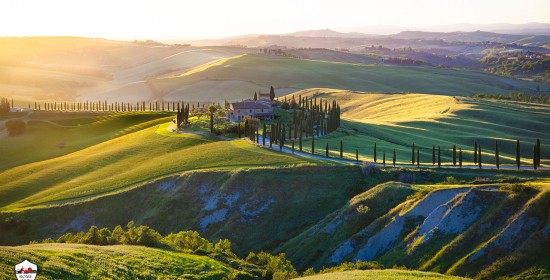
PRO TIP: Searching Hidden Tuscany treatures beyond the vineyards and discover the land of forgotten lore? Save this article in your browser's “Tuscany” folder for easy reference during your Italy trip planning. For private Italy tours, we invite you to browse through our website.
Buongiorno and welcome to RomeCabs, Rome’s top-rated company for Tuscany tours from Rome. Many travelers seek to discover the hidden Tuscany - the land of forgotten lore that lies beyond the vineyards and bustling Tuscan cities that typically characterize Tuscany.
To authentically experience Tuscany, it’s essential to immerse yourself in the captivating blend of hidden villages, ancient traditions, and landscapes that have served as timeless inspiration for poets and artists.
In this travel blog, we have carefully selected seven enchanting places in Tuscany that embody the hidden essence of Tuscany, each unveiling the soul of this captivating region, beckoning discovery one tale at a time.
Hidden Tuscany:
Beyond the Vineyards, a Land of Forgotten Lore
Crete Senesi - Discover the Enchanting Landscapes
Located in the southeast area of Siena, Le Crete Senesi (or simply "The Crete”) is a distinctive landscape that unfolds like a dream. This area is renowned for its mesmerizing and otherworldly appearance, characterized by rolling hills, clay-rich terrain, and a color palette that shifts through various earthy tones. The name "Crete Senesi" translates to "Sienese clays", a nod to the specific geological composition that defines this extraordinary region.
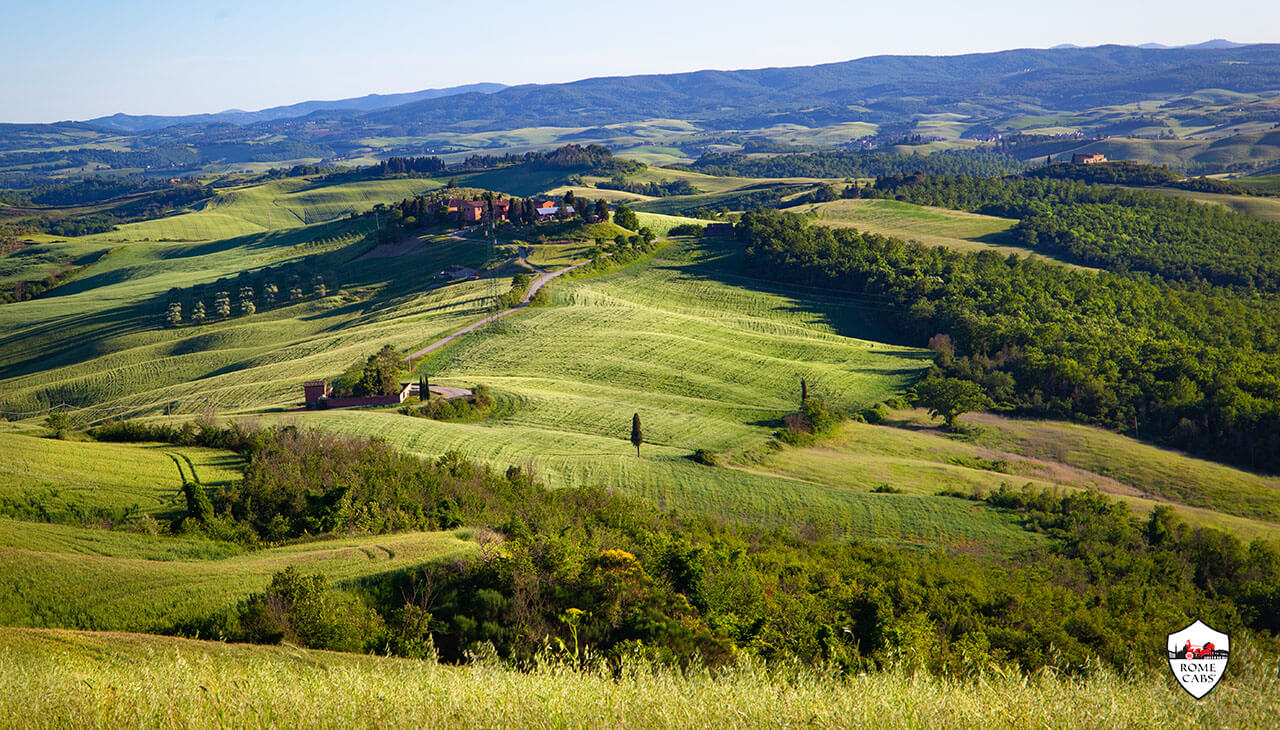
The Crete Senesi sits on a foundation of clay, creating a terrain with distinctive grayish-brown hues often described as lunar. The distinctive clay, combined with rock salt and chalk, known as mattaione, is composed of sediments from the Pliocene sea that once submerged the region approximately 2.5 to 4.5 million years ago. Essentially, it reflects the geological remnants of that ancient sea in the form of sedimentary deposits.
Over millions of years, geological processes, including erosion and sedimentation, shaped the hills and valleys of Le Crete Senesi. The softer clay layers were sculpted by wind and water, resulting in the undulating forms seen today. Atop these hills, you'll find isolated farms, cypress trees, and stretches of forest within the depressions.
The agricultural practices in this region have played a significant role in shaping the landscape. The gentle slopes of the hills have been cultivated for centuries, creating a harmonious blend of human activity and natural beauty. Olive groves, vineyards, and wheat fields contribute to the patchwork quilt-like appearance of the terrain. Le Crete is not just a physical exploration; it's a soulful odyssey.
Rather than prominent landmarks like squares, cathedrals, or monuments, Le Crete reveals its identity through a solitary cypress tree, an ancient farm, the curve of a white road, or an undulating lunar hill.
The ethereal beauty of Le Crete Senesi has not only shaped the physical environment but has also inspired artists through the ages, writers, and photographers. The unique play of light and shadow, especially during sunrise and sunset, adds a dreamlike quality to the scenery, making it a muse for creative expression and one of the most fascinating places to discover in hidden Tuscany.
Best Times of the Year to Visit Le Crete Senesi
Spring and autumn emerge as the ideal seasons to explore the Crete Senesi.
- Spring brings a burst of colors with blooming flowers, creating an enchanting atmosphere.
- Summer brings out the golden hues of the ripe fields of wheat.
- Autumn transforms the landscape with warm hues of red, orange, and brown, accentuating the beauty of the landscape.
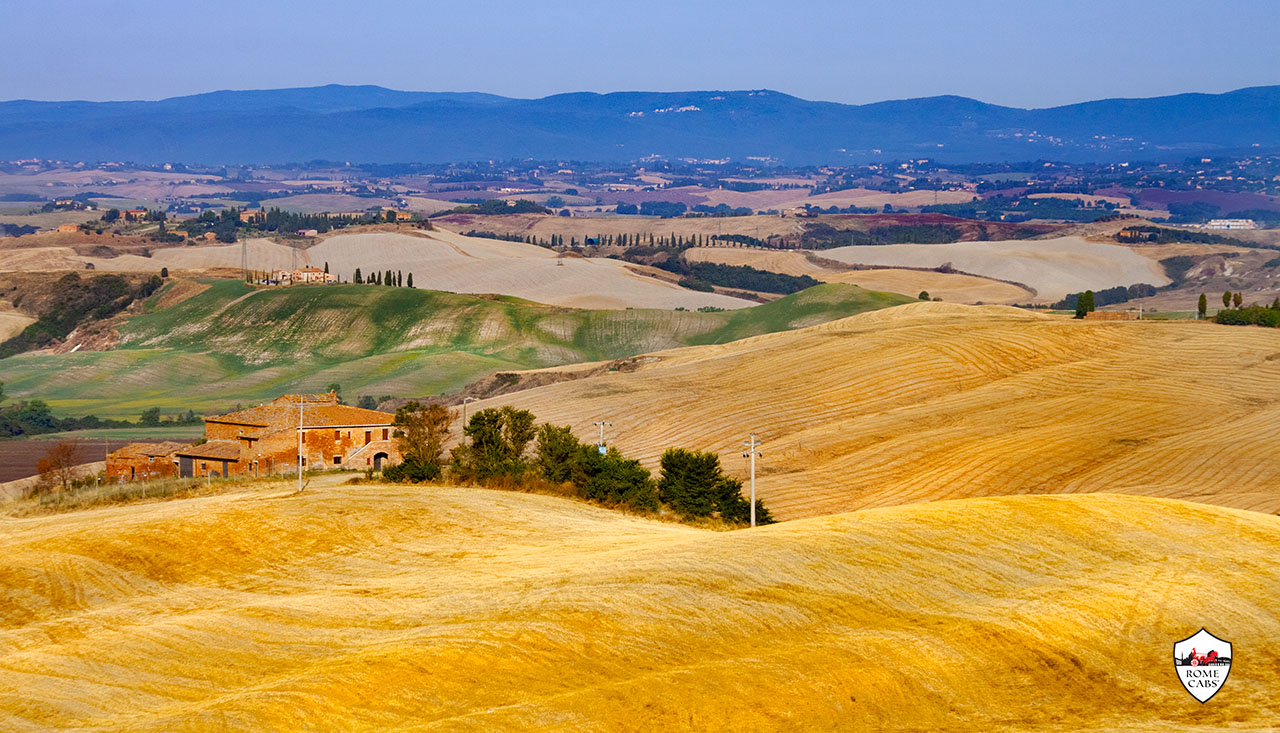
Exploring the Boundless Beauty of Le Crete Senesi
Beyond the captivating landscapes, the Crete Senesi is home to artistic and spiritual treasures. The Monte Oliveto Maggiore convent is a must-visit, adorned with frescoes by Luca Signorelli and Sodoma that grace the walls of corridors and the church. The medieval village of Asciano, with its historic center and museums, offers a journey through time.
Several villages dot the Crete Senesi, each offering a unique charm. Asciano, with its medieval center, Basilica of Sant'Agata, and Torre della Mencia, stands out. Buonconvento, a medieval village on the Via Francigena, boasts historical and artistic landmarks. Rapolano Terme invites relaxation with its thermal waters and historic sites, while Trequanda, nestled on the border, captivates with a medieval fortress and picturesque churches.
Abbey of San Galgano: Legendary Sword in the Stone
The Cistercian abbey of San Galgano is a visual feast located between Chiusdino and Monticiano in Tuscany and shrouded in legends. Founded as a Cistercian Monastery in the valley of the river Merse, the abbey's construction began around 1220, reaching completion some six decades later. The Gothic-style 13th-century church, despite being roofless today, continues to inspire awe, offering a ghostly yet fascinating silhouette.
The abbey thrived initially but faced desolation in the 14th century due to raids by roving condottieri (mercenaries), leaving only the abbot within its walls. Despite its somewhat isolated location, the abbey attracts thousands of visitors yearly, drawn by its historic significance and undeniable allure.
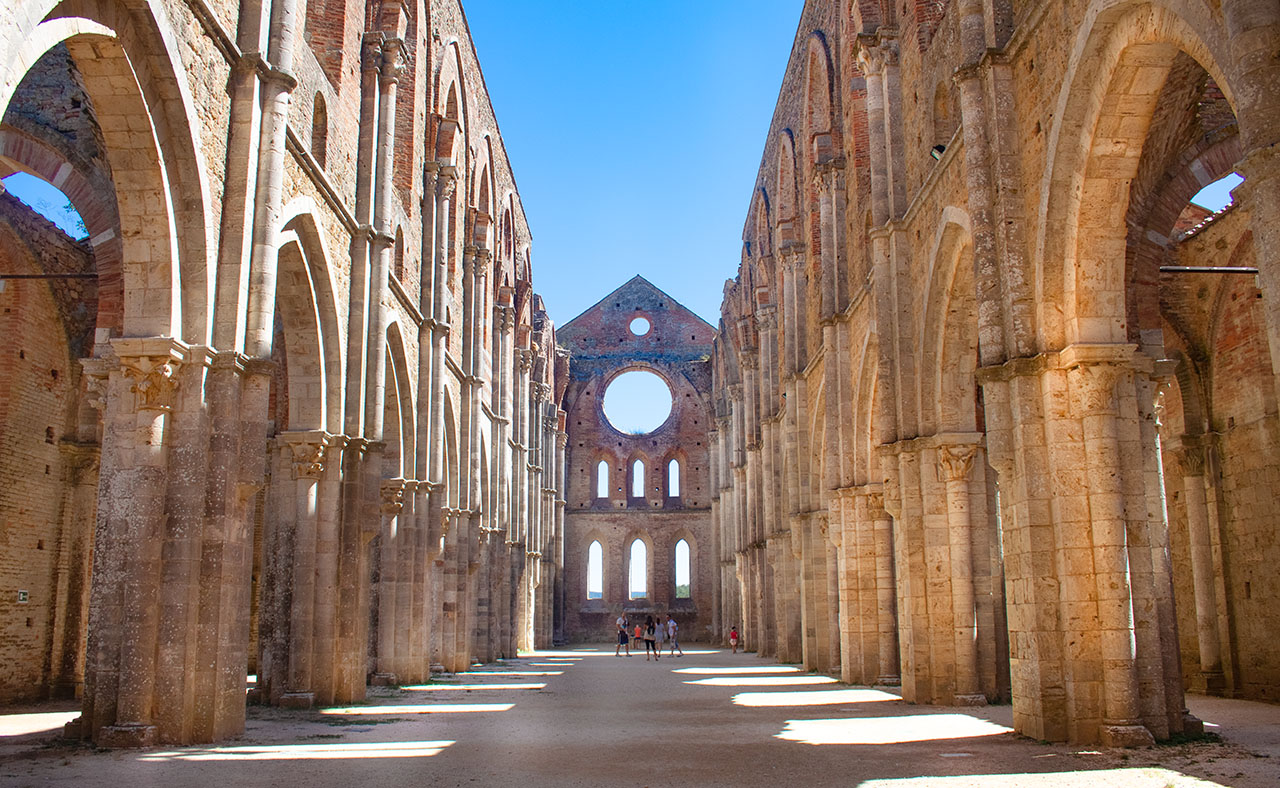
The Montesiepi Hermitage and the Sword in the Stone
Adjacent to the abbey lies the Montesiepi hermitage, a site of profound significance in the life of San Galgano, a medieval Tuscan knight named Galgano Guidotti turned hermit and saint. Born in the 12th century, San Galgano is renowned for his spiritual transformation and the establishment of a hermitage atop the hill where the Montesiepi Hermitage now stands.
Constructed at the end of the 1100s, the hermitage predates the abbey itself. The hermitage, initially built in a circular shape, consists of a small church, a chapel adorned with frescoes by Ambrogio Lorenzetti, and a bell tower. Over time, it became part of a larger structure dedicated to the cult of San Galgano.
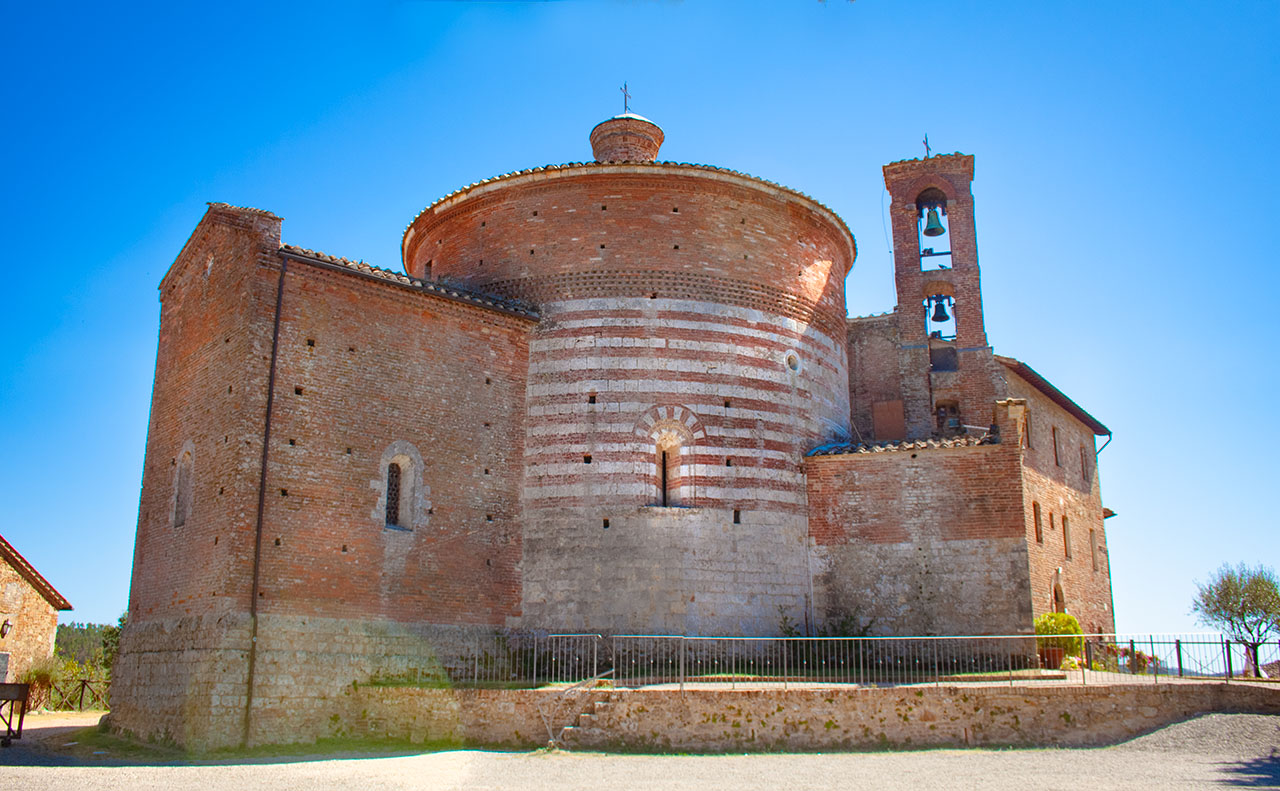
The Legend of the Sword in the Stone
At the heart of the Montesiepi hermitage lies a legendary relic—the Sword in the Stone.
According to legend, Saint Galgano was born Galgano Guidotti in the 12th century. He was initially a wealthy nobleman trained in the art of war, known for his hedonistic lifestyle. However, a pivotal moment occurred when Archangel Michael, often depicted as a warrior saint wielding a sword, intervened in Galgano's life, leading to a profound shift.
Despite facing ridicule from loved ones, the knight resolved to become a hermit, following his inner calling. This decision sparked strong opposition from his family, but their efforts to dissuade him proved unsuccessful. Guided by a celestial voice to the summit of Montesiepi, Galgano envisioned a circular temple dedicated to the Blessed Virgin Mary, God, and Archangel Michael.
Upon reaching the hilltop, he felt inspired to renounce worldly desires, symbolized by thrusting his sword into the stone. Subsequently, Saint Galgano lived as a hermit on Montesiepi, later canonized by the Church, reportedly the first saint formally recognized by Pope Urban III.
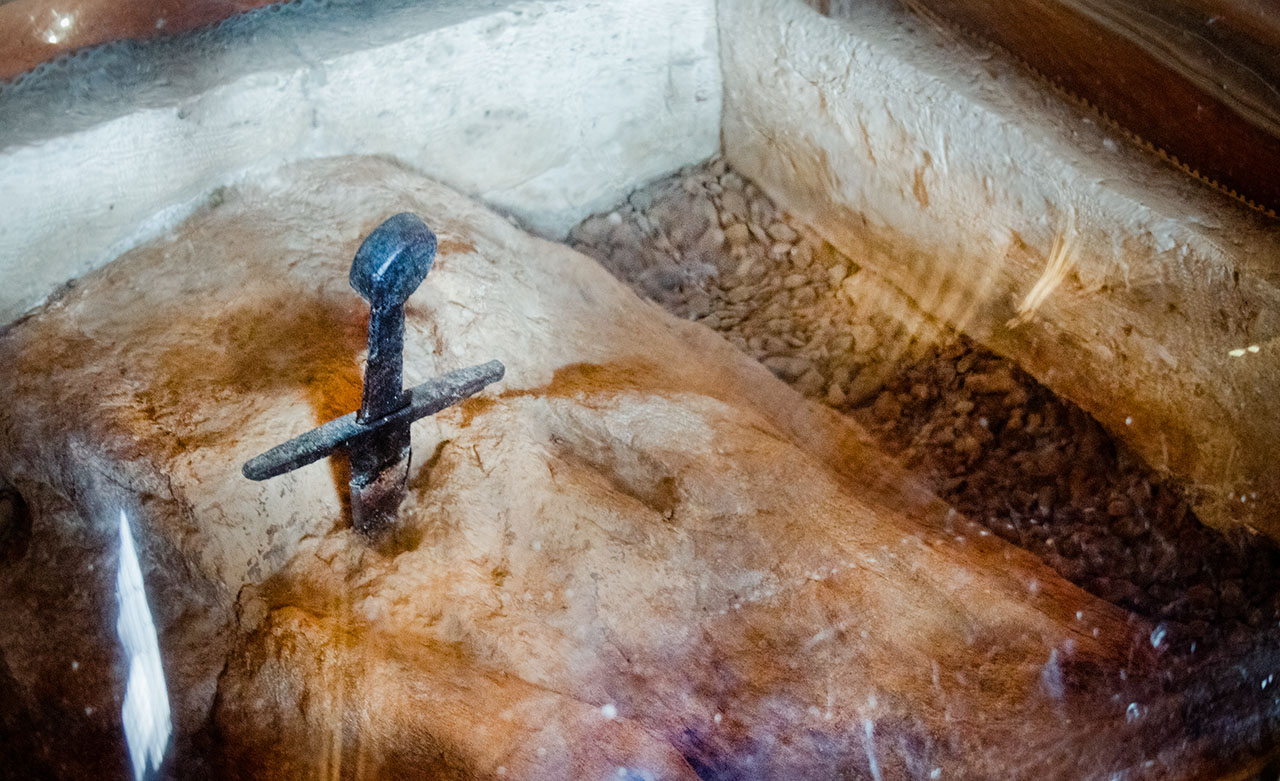
Following Galgano's death in 1182, the envisioned round temple materialized into the "Rotonda di Montesiepi", a circular church. The Montesiepi Chapel, which currently houses medieval artifacts, features the genuine Sword in the Stone as its centerpiece. This artifact is now safeguarded by plexiglass due to numerous attempts to remove it, attracting visitors fascinated by its historical significance.
While initially regarded as a potential fake, recent studies have indicated that the sword's material dates back to the period from 1100 to 1200, lending authenticity to the intriguing legend.
The connection between the myth of the sword in the stone and England's tales of King Arthur and the Knights of the Round Table, particularly Sir Gawaine (Galganus), suggests the possibility that the legend was transmitted to England through stories shared by European pilgrims during the Medieval Age, where Italy's Via Francigena played a pivotal role in European travels.
Bagno Vignoni: Thermal Harmony
Next on our list of hidden Tuscany is Bagno Vignoni, where ancient thermal baths have welcomed visitors for centuries. Stepping into Bagno Vignoni's main square "Piazza delle Sorgenti" (Square of the Springs) is a departure from the ordinary. Instead of a conventional piazza, you're greeted by a remarkable sight—a pool fed by thermal waters. This unique architectural feature sets Bagno Vignoni apart, creating a tranquil oasis at the heart of the town.
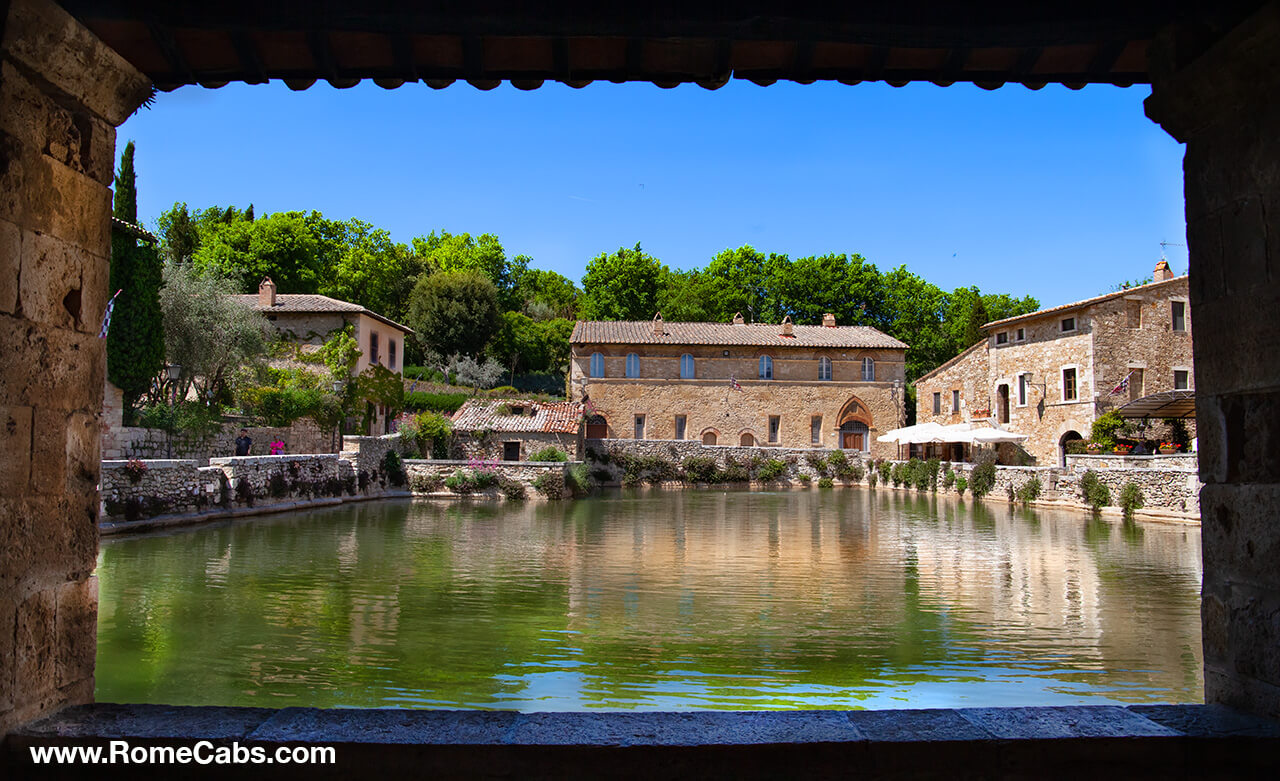
Dating back to Roman times, these thermal waters have played a pivotal role in the region's history. Emperors, poets, and nobility sought solace in the healing embrace of Bagno Vignoni's rejuvenating springs, transforming the town into a retreat for body and soul.
The harmonious blend of Medieval stone buildings reflecting in the watery square adds to the town's architectural charm. As you explore the narrow streets, each corner reveals a piece of history, enticing restaurants and cafes, or inviting boutiques.
Bagno Vignoni is located in the heart of Val d’Orcia a testament to the natural wonders that define Tuscany. The surrounding countryside, adorned with vineyards and rolling hills, provides a picturesque backdrop to the thermal haven.
Whether you're seeking physical renewal, a tranquil retreat, or just a stop along your journey through Tuscany, Bagno Vignoni invites you to partake in its unique blend of history, architecture, and natural springs.
- Our Top Selling Enchanting Tuscany Tour includes visits to Monticchiello, Bagno Vignoni, Spedaletto, San Quirico d'Orcia, and Pienza (see most of these amazing places featured in this blog)
Monticchiello: A Timeless Marvel
Tucked away amidst the picturesque landscapes of Tuscany, Monticchiello is a charming medieval walled village that beckons with its rich history, architectural wonders, and a unique cultural tradition that sets it apart from its illustrious neighbors, Pienza and Montepulciano.
Monticchiello's history unfolds like a well-worn manuscript with roots reaching not only back to medieval times but also to the Roman gens Clelia. The Cassero Tower and city walls, remnants of a robust fortification system dating back to 1260, bear witness to Monticchiello's strategic significance.
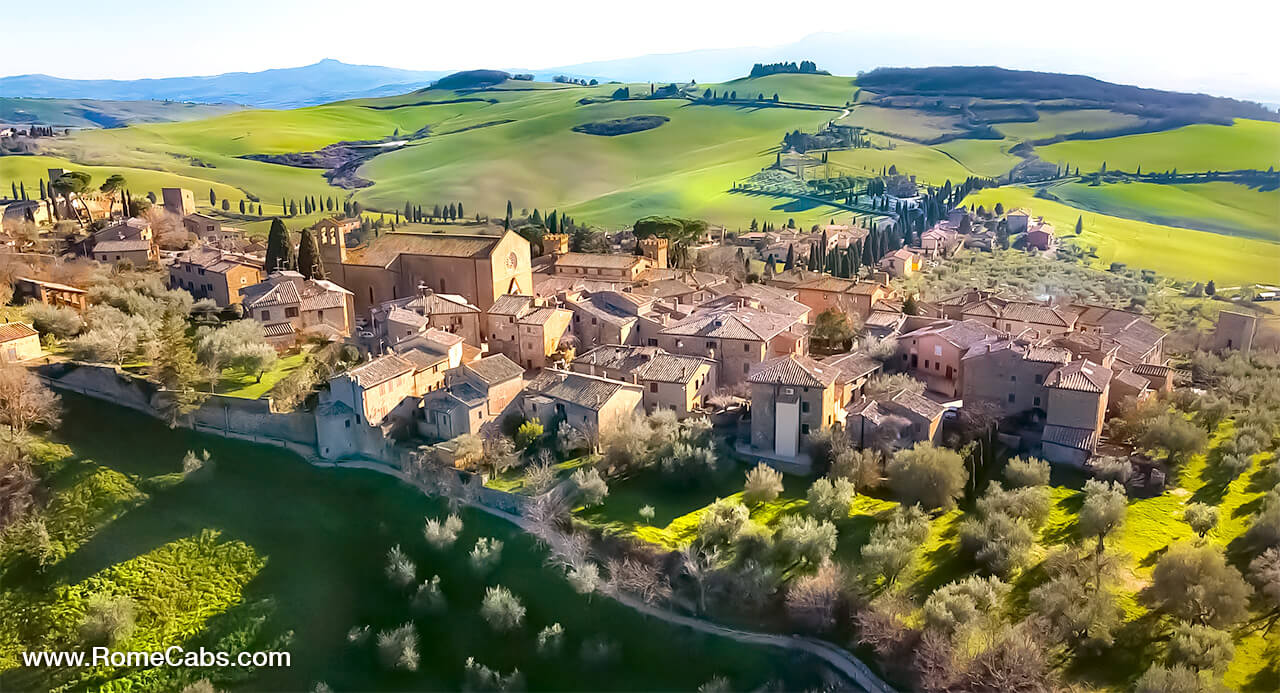
Monticchiello's history is deeply intertwined with the ebb and flow of regional powers. Passing under the protection of Siena, the village took its current form in the 1200s, marked by the construction of walls, the keep, and the establishment of municipal institutions regulated by vernacular statutes. After the fall of the Sienese Republic in 1559, Monticchiello gradually ceded its importance under the Medici and became part of the municipal jurisdiction of Pienza in 1777.
Explore the quaint charm of Monticchiello, perfect for a brief yet delightful visit. Wander through its immaculate medieval streets, tracing stone walls and narrow lanes. Stop at the parish church of Saints Leonardo and Christopher, a Romanesque-Gothic testament to the village's medieval grandeur. Pause at a local cafe for respite or indulge in a leisurely meal at one of the village restaurants. Unmissable is the terrace offering a panoramic spectacle of Val d'Orcia, with the distant silhouette of Pienza.
Near Monticchiello is also the famed "Windy Road", a picturesque road that winds up a hill lined with cypress trees, visible from a vantage point on the opposite hill.
- Apart from Enchanting Tuscany Tour, our VALLEY OF PARADISE Tuscany Tour from Rome also includes a stop in Montichiello to see this windy road for yourself!
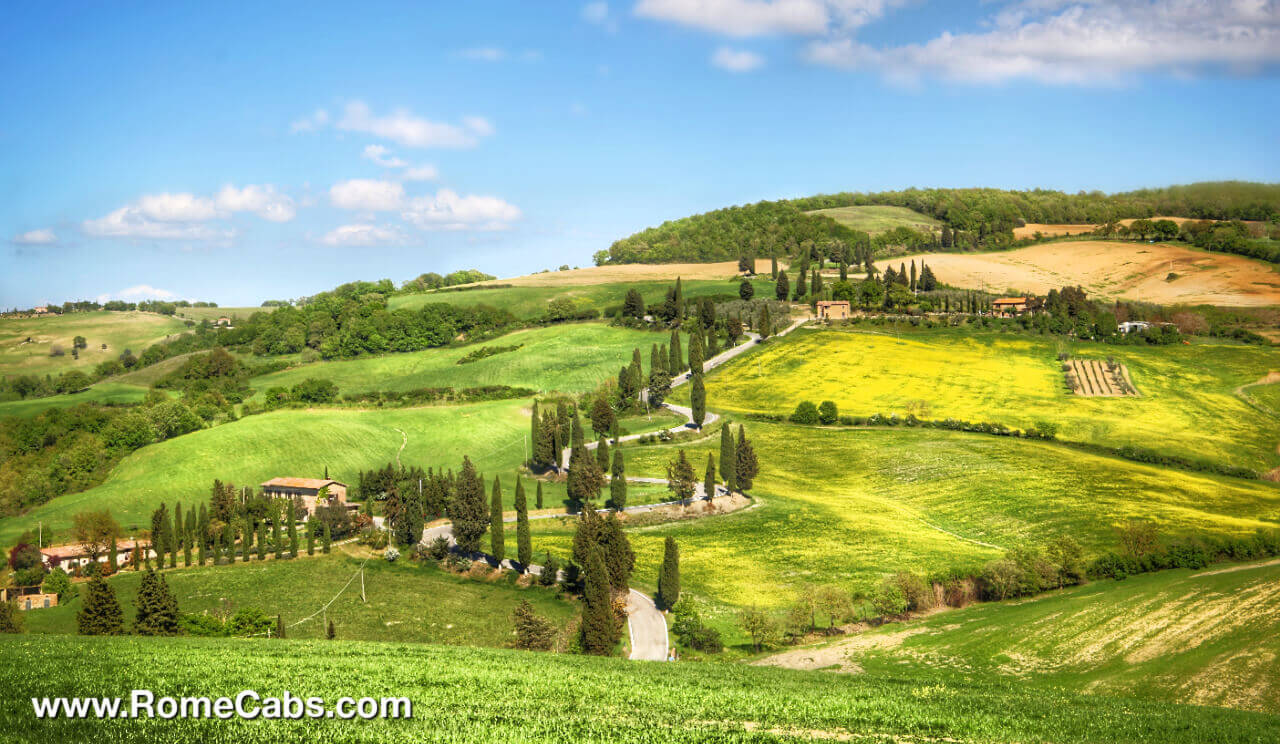
Vitaleta: An Iconic Chapel in the Val d'Orcia Hills
Located in the undulating hills between San Quirico d'Orcia and Pienza in the Val d'Orcia is the timeless and enchanting Chapel of the Madonna di Vitaleta, a UNESCO World Heritage Site, guarded by two majestic rows of cypress trees.
According to local folklore, the chapel traces its origins to a sacred encounter—a divine apparition of Mary to a shepherdess. This mystical event is believed to have inspired the construction of the chapel, serving as a spiritual beacon in the heart of the Val d'Orcia. In 1553, the renowned artist Andrea della Robbia crafted a statue of the Virgin Mary, which found its home within the chapel. Today, this precious artwork is housed in the Church of the Madonna di Vitaleta in the center of San Quirico.
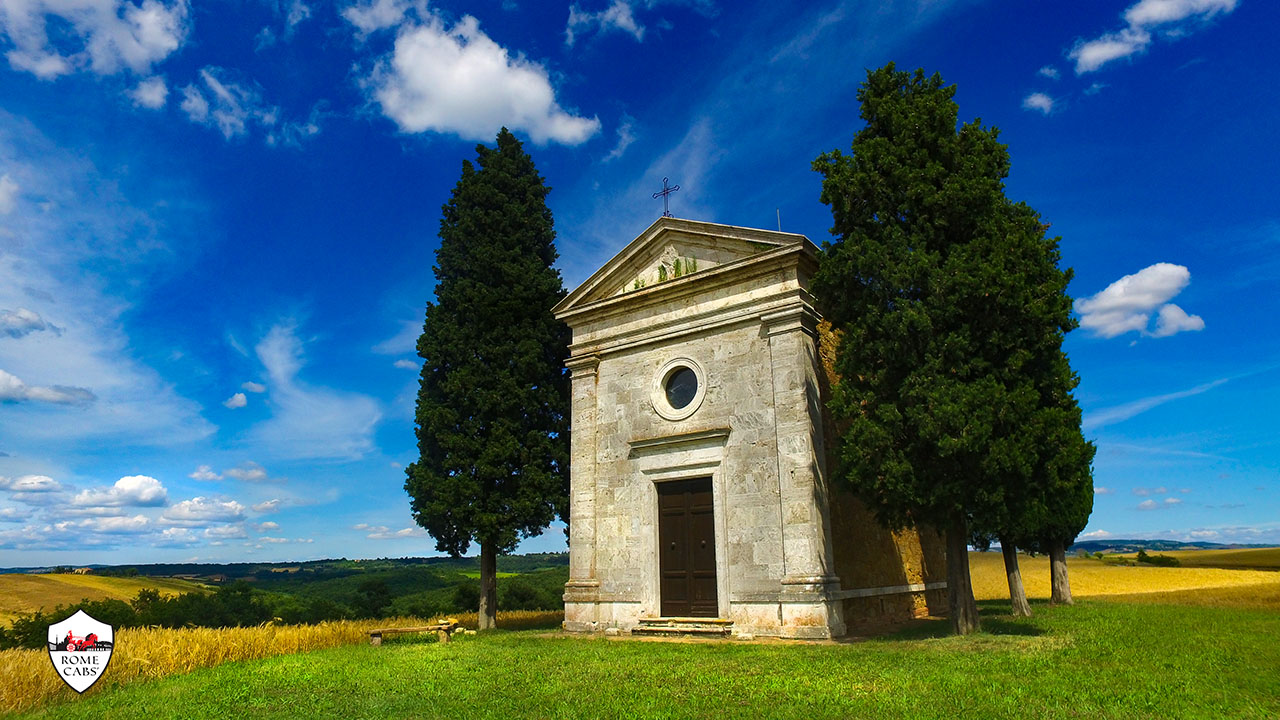
The present-day chapel, with its elegant and unassuming facade, is the result of a 19th-century restoration and redesign by the skilled hands of Giuseppe Partini. Fashioned from Rapolano stone and adorned with a delicate rose window, the chapel exudes simplicity and grace. Its appearance harmonizes seamlessly with the surrounding countryside, making it a captivating subject for photographers and a beloved spot for romantic excursions.
Under the stewardship of Pasquale Forte, a visionary entrepreneur deeply connected to the spiritual essence of the land, the Chapel of Vitaleta has undergone a profound revival. Restoring its original purpose of religious reverence, the chapel has been meticulously renovated, preserving its inherent simplicity while imbuing it with renewed vitality.
Nowadays, Vitaletta is a chapel that hosts weddings, and nearby buildings transformed into cafes and fine restaurants, inviting visitors to step into a world where legends meet architecture, and time seems to pause in reverence to the beauty that unfolds in the heart of Tuscany's Val d'Orcia.
Hidden Tuscany Treasure: Spedaletto Castle
Just a short drive from Montichiello lies the captivating Spedaletto Castle, an ancient 14th-century fortress with a rich history. Initially established in the late 12th century as a shelter for pilgrims on the Francigena route to Rome, the castle later became a "grancia", a large medieval agricultural farm of Cistercian origin. Transformed into a magnificent fortified castle by the end of the 14th century, Spedaletto boasts crenelated walls, imposing towers, and a fortified entrance with a formidable keep.
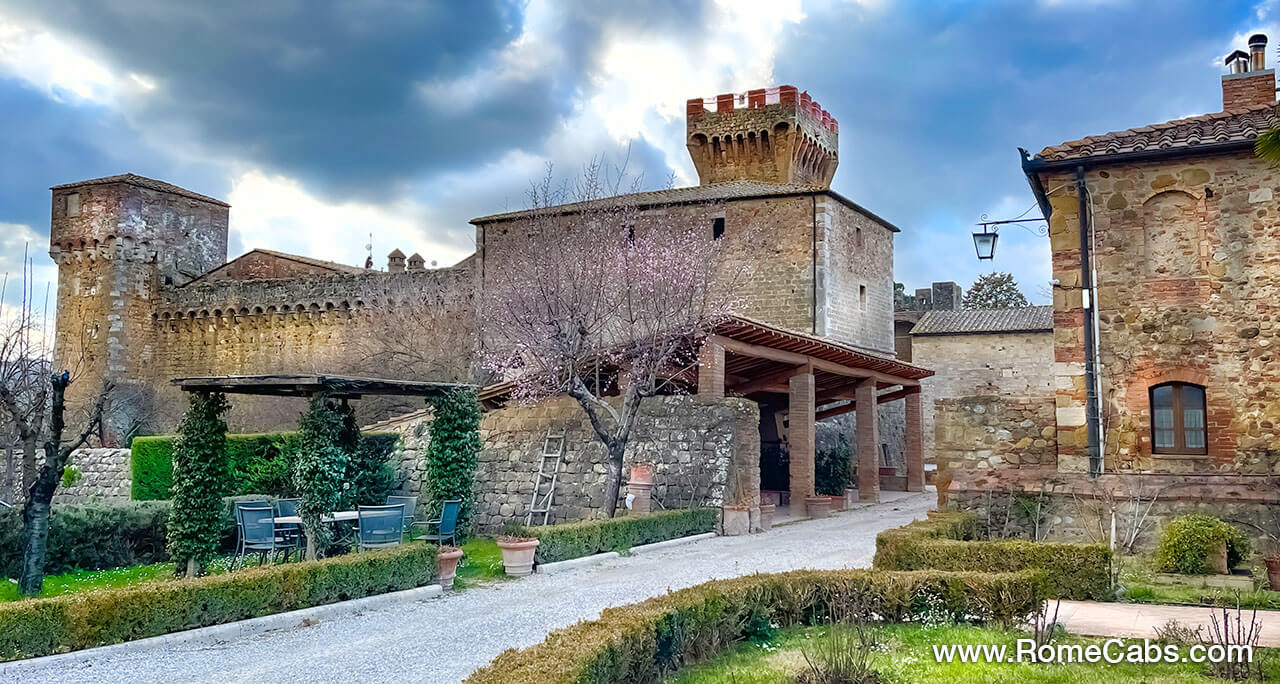
Formerly a place that hosted notable figures like Pope Pius II and Charles II of Anjou, Spedaletto now serves as an agriturismo farmhouse. The castle's old mill house, once the site where organic grain was ground into flour, has been converted into a charming shop. Here, you can find a diverse selection of organic artisanal whole-grain pasta, produced from local flour ground at the farm's larger mill in Montichiello. The shop also offers farm-made virgin olive oil, organic wine, artisan beer, and baked goods – perfect as souvenirs or gifts.
Saturnia: Mythical Waters
Another hidden Tuscany destination is Saturnia, where legendary waters and ancient tales intertwine in a harmonious dance. Named after the god Saturn, this haven of thermal springs beckons travelers to partake in an age-old tradition steeped in mythology.
Saturnia derives its name from the Roman god Saturn, who, in mythology, is associated with agriculture and abundance. According to ancient lore, it is believed that in a fit of anger, Saturn thrust his mighty trident into the ground, causing the earth to split open and hot thermal waters to gush forth. Thus, the mythological origins of Saturnia's famed springs echo the divine touch of the god himself.
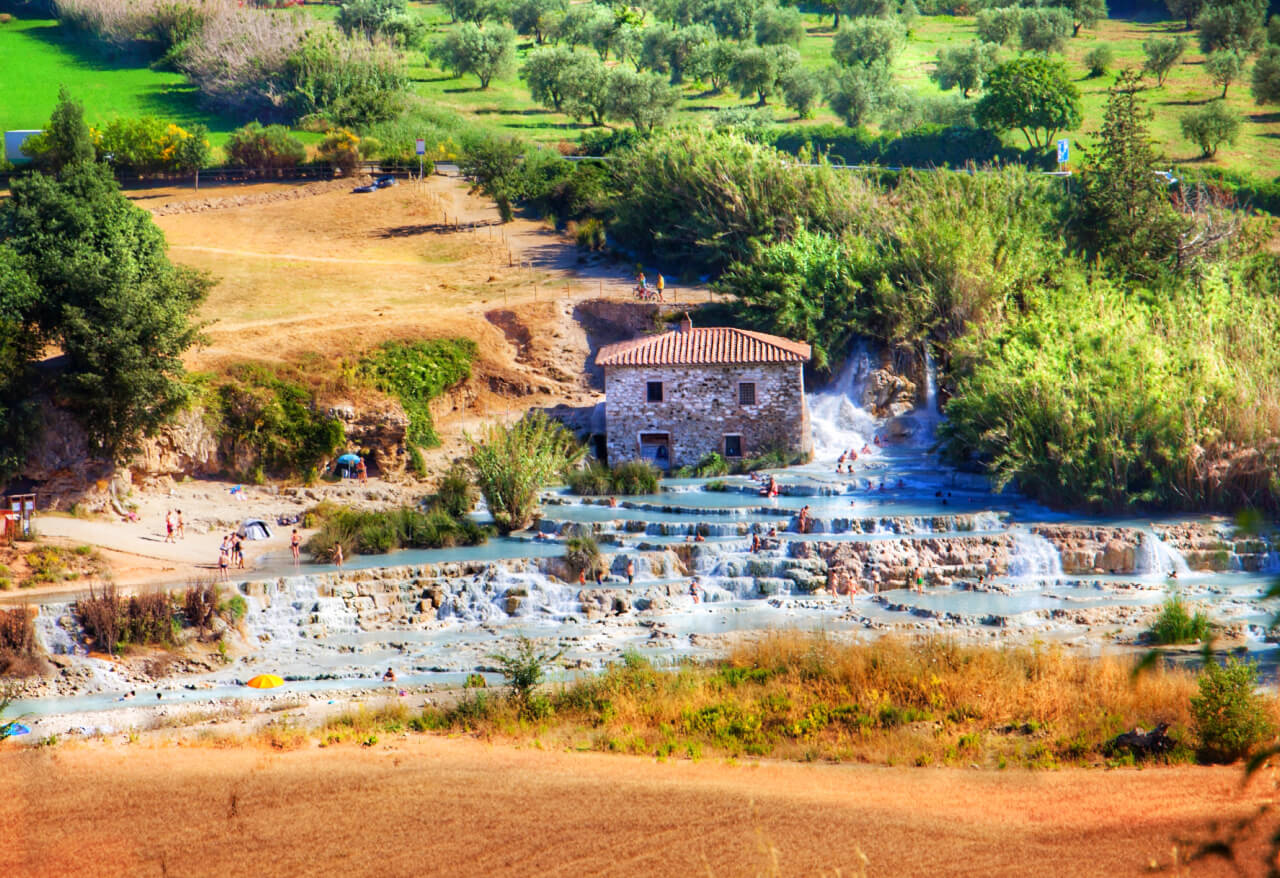
These therapeutic waters, a gift from the gods, have been revered since antiquity for their healing properties. Rich in minerals and flowing at a constant temperature, the thermal baths of Saturnia offer a rejuvenating experience amidst nature's embrace. As you submerge yourself in the warm embrace of these legendary waters, you become part of a timeless tradition that has drawn visitors seeking healing and relaxation for centuries.
Surrounded by lush greenery, the thermal baths create an oasis of tranquility, inviting you to unwind and connect with the natural wonders that define Saturnia. The backdrop of rolling hills and verdant landscapes enhances the enchantment, making your visit not just a spa experience but a voyage into the heart of mythical narratives.
Whether you seek healing or simply wish to immerse yourself in the mythical ambiance, Saturnia's thermal baths provide a unique opportunity to connect with the ancient tales that have shaped the very essence of this enchanting region.
We make getting from Rome / Airport to Saturnia effortless and convenient on our Private Long Distance Transfers in Italy.
Hidden Tuscany: A Journey of Tales, Treasures, and Timeless Marvels
Tuscany is a treasure trove of enchanting landscapes, medieval marvels, and mythical waters, inviting travelers to explore the region's rich history and cultural treasures hidden from the main tourist paths.
This journey unveils a Tuscany beyond the postcard images, where each destination tells a unique story, inviting travelers to uncover the region's hidden treasures one captivating tale at a time.
Thank you for reading our travel blog Hidden Tuscany: Beyond the Vineyards, a Land of Forgotten Lore, and for choosing RomeCabs for your private tours in Italy. We look forward to showing you the best Italy has to offer!
* Find us online also on:
- RomeCabs FACEBOOK
- RomeCabs PINTEREST
- RomeCabs TWITTER
- RomeCabs INSTAGRAM
- RomeCabs FLICKR Photo Gallery
- RomeCabs Recommended on Cruise Critic
